Narrative and Pictorial Review on State-of-the-Art Endovascular Treatment for Focal Non-Infected Lesions of the Abdominal Aorta: Anatomical Challenges, Technical Solutions, and Clinical Outcomes
Abstract
1. Introduction: Aetiology, Natural History and Morphology
1.1. Saccular Aneurysms
1.2. Penetrating Aortic Ulcer (PAU)
2. Indications for Treatment and Synthesis of the Available Literature (Open Surgery vs. Endovascular Therapy)
3. Challenges with Endovascular Repair of Focal Lesions of the Abdominal Aorta
4. Case Examples and Technical Solutions
4.1. Infrarenal EVAR
4.2. Fenestrated-Branched Options for Disease Involving the Para-Visceral Aorta
5. Conclusions: Evidence Summary, Unmet Needs and Future Directions
Author Contributions
Funding
Institutional Review Board Statement
Informed Consent Statement
Data Availability Statement
Conflicts of Interest
Abbreviations
| Complete name | Abbreviation |
| non-infected lesions of the abdominal aorta | fl-AAA |
| Penetrating aortic ulcers | PAU |
| intramural hematoma | IMH |
| Saccular aneurysm | sa-AAA |
| Fenestrated endovascular aneurysm repair | FEVAR |
| abdominal aortic aneurysms | AAA |
| infective native aortic aneurysms | INAA |
| aortic dissection | AD |
| descending thoracic aorta | DTA |
| abdominal aorta | AA |
| European Society of Vascular Surgery | ESVS |
| Society for Vascular Surgery | SVS |
| endovascular aneurism repair | EVAR |
| open surgery repair | OSR |
| saccular lesion of abdominal aorta | sl-AAs |
| computed tomography angiography | CTA |
| complex abdominal aneurysmand | cAAA |
| thoracoabdominal aneurysms | TAAA |
| target visceral vessel | TVV |
References
- Minor, M.E.; Menzoian, J.O.; Raffetto, J.D. Noninfectious Saccular Abdominal Aortic Aneurysm—A Report of Two Cases. Vasc. Endovasc. Surg. 2003, 37, 353–358. [Google Scholar] [CrossRef] [PubMed]
- Coady, M.A.; Rizzo, J.A.; Hammond, G.L.; Pierce, J.G.; Kopf, G.S.; Elefteriades, J.A.; Donaldson, M.C. Penetrating Ulcer of the Thoracic Aorta: What Is It? How Do We Recognize It? How Do We Manage It? J. Vasc. Surg. 1998, 27, 1006–1016. [Google Scholar] [CrossRef] [PubMed]
- Brown, S.L.; Busuttil, R.W.; Baker, J.D.; Machleder, H.I.; Moore, W.S.; Barker, W.F. Bacteriologic and Surgical Determinants of Survival in Patients with Mycotic Aneurysms. J. Vasc. Surg 1984, 1, 541–547. [Google Scholar] [CrossRef] [PubMed]
- Wyss, T.R.; Giardini, M.; Sörelius, K.; Adam, D.; Assadian, O.; Beck, A.W.; Berard, X.; Boutoille, D.; Budtz-Lilly, J.; Chakfé, N.; et al. Infective Native Aortic Aneurysm: A Delphi Consensus Document on Treatment, Follow Up, and Definition of Cure. Eur. J. Vasc. Endovasc. Surg. 2024, 67, 654–661. [Google Scholar] [CrossRef]
- Frösen, J.; Piippo, A.; Paetau, A.; Kangasniemi, M.; Niemelä, M.; Hernesniemi, J.; Jääskeläinen, J. Remodeling of Saccular Cerebral Artery Aneurysm Wall Is Associated with Rupture: Histological Analysis of 24 Unruptured and 42 Ruptured Cases. Stroke 2004, 35, 2287–2293. [Google Scholar] [CrossRef]
- Rutherford’s Vascular Surgery and Endovascular Therapy, 2-Volume Set—9th Edition. Available online: https://www.elsevier.com/books/rutherfords-vascular-surgery-and-endovascular-therapy-2-volume-set/sidawy/978-0-323-42791-3 (accessed on 16 May 2022).
- Baird, I.M. Saccular Aneurysms of the Abdominal Aorta; Report of Three Cases and Review. AMA Arch. Intern. Med. 1953, 91, 626–632. [Google Scholar] [CrossRef]
- Karthaus, E.G.; Tong, T.M.L.; Vahl, A.; Hamming, J.F. Saccular Abdominal Aortic Aneurysms: Patient Characteristics, Clinical Presentation, Treatment, and Outcomes in the Netherlands. Ann. Surg. 2019, 270, 852–858. [Google Scholar] [CrossRef] [PubMed]
- Shang, E.K.; Nathan, D.P.; Boonn, W.W.; Lys-Dobradin, I.A.; Fairman, R.M.; Woo, E.Y.; Wang, G.J.; Jackson, B.M. A Modern Experience with Saccular Aortic Aneurysms. J. Vasc. Surg. 2013, 57, 84–88. [Google Scholar] [CrossRef]
- DeCarlo, C.; Latz, C.A.; Boitano, L.T.; Kim, Y.; Tanious, A.; Schwartz, S.I.; Patell, R.; Mohebali, J.; Dua, A. Prognostication of asymptomatic penetrating aortic ulcers: A modern approach. Circulation 2021, 144, 1091–1101. [Google Scholar] [CrossRef]
- Shennan, T. Dissecting Aneurysms; By Special Report Series, No. 193. (Medical Research Council); His Majesty’s Stationery: London, UK, 1934. [Google Scholar]
- Stanson, A.W.; Kazmier, F.J.; Hollier, L.H.; Edwards, W.D.; Pairolero, P.C.; Sheedy, P.F.; Joyce, J.W.; Johnson, M.C. Penetrating Atherosclerotic Ulcers of the Thoracic Aorta: Natural History and Clinicopathologic Correlations. Ann. Vasc. Surg. 1986, 1, 15–23. [Google Scholar] [CrossRef]
- Lansman, S.L.; Saunders, P.C.; Malekan, R.; Spielvogel, D. Acute Aortic Syndrome. J. Thorac. Cardiovasc. Surg. 2010, 140, S92–S97. [Google Scholar] [CrossRef] [PubMed]
- Cooke, J.P.; Kazmier, F.J.; Orszulak, T.A. The Penetrating Aortic Ulcer: Pathologic Manifestations, Diagnosis, and Management. Mayo Clin. Proc. 1988, 63, 718–725. [Google Scholar] [CrossRef]
- Rothwell, P.M.; Coull, A.J.; Silver, L.E.; Fairhead, J.F.; Giles, M.F.; Lovelock, C.E.; Redgrave, J.N.E.; Bull, L.M.; Welch, S.J.V.; Cuthbertson, F.C.; et al. Population-Based Study of Event-Rate, Incidence, Case Fatality, and Mortality for All Acute Vascular Events in All Arterial Territories (Oxford Vascular Study). Lancet 2005, 366, 1773–1783. [Google Scholar] [CrossRef]
- Macura, K.J.; Corl, F.M.; Fishman, E.K.; Bluemke, D.A. Pathogenesis in Acute Aortic Syndromes: Aortic Aneurysm Leak and Rupture and Traumatic Aortic Transection. Am. J. Roentgenol. 2003, 181, 303–307. [Google Scholar] [CrossRef] [PubMed]
- Harris, J.A.; Bis, K.G.; Glover, J.L.; Bendick, P.J.; Shetty, A.; Brown, O.W. Penetrating Atherosclerotic Ulcers of the Aorta. J. Vasc. Surg. 1994, 19, 90–99. [Google Scholar] [CrossRef] [PubMed]
- Nathan, D.P.; Boonn, W.; Lai, E.; Wang, G.J.; Desai, N.; Woo, E.Y.; Fairman, R.M.; Jackson, B.M. Presentation, Complications, and Natural History of Penetrating Atherosclerotic Ulcer Disease. J. Vasc. Surg. 2012, 55, 10–15. [Google Scholar] [CrossRef]
- Batt, M.; Haudebourg, P.; Planchard, P.F.; Ferrari, E.; Hassen-Khodja, R.; Bouillanne, P.J. Penetrating Atherosclerotic Ulcers of the Infrarenal Aorta: Life-Threatening Lesions. Eur. J. Vasc. Endovasc. Surg. 2005, 29, 35–42. [Google Scholar] [CrossRef]
- Kotsis, T.; Spyropoulos, B.G.; Asaloumidis, N.; Christoforou, P.; Katseni, K.; Papaconstantinou, I. Penetrating Atherosclerotic Ulcers of the Abdominal Aorta: A Case Report and Review of the Literature. Vasc. Spec. Int. 2019, 35, 152–159. [Google Scholar] [CrossRef]
- Patel, H.J.; Williams, D.M.; Upchurch, G.R.; Dasika, N.L.; Deeb, G.M. The Challenge of Associated Intramural Hematoma with Endovascular Repair for Penetrating Ulcers of the Descending Thoracic Aorta. J. Vasc. Surg. 2010, 51, 829–835. [Google Scholar] [CrossRef]
- Piffaretti, G.; Tozzi, M.; Lomazzi, C.; Rivolta, N.; Riva, F.; Maida, S.; Caronno, R.; Laganà, D.; Carrafiello, G.; Cuffari, S.; et al. Penetrating Ulcers of the Thoracic Aorta: Results from a Single-Centre Experience. Am. Surg. 2007, 193, 443–447. [Google Scholar] [CrossRef]
- Geisbüsch, P.; Kotelis, D.; Weber, T.F.; Hyhlik-Dürr, A.; Kauczor, H.U.; Böckler, D. Early and Midterm Results after Endovascular Stent Graft Repair of Penetrating Aortic Ulcers. J. Vasc. Surg. 2008, 48, 1361–1368. [Google Scholar] [CrossRef] [PubMed]
- Brinster, D.R.; Wheatley, G.H.; Williams, J.; Ramaiah, V.G.; Diethrich, E.B.; Rodriguez-Lopez, J.A. Are Penetrating Aortic Ulcers Best Treated Using an Endovascular Approach? Ann. Thorac. Surg. 2006, 82, 1688–1691. [Google Scholar] [CrossRef]
- Dalainas, I.; Nano, G.; Medda, M.; Bianchi, P.; Casana, R.; Ramponi, F.; Stegher, S.; Malacrida, G.; Inglese, L.; Tealdi, D.G. Endovascular Treatment of Penetrating Aortic Ulcers: Mid-Term Results. Eur. J. Vasc. Endovasc. Surg. 2007, 34, 74–78. [Google Scholar] [CrossRef] [PubMed]
- Cho, K.R.; Stanson, A.W.; Potter, D.D.; Cherry, K.J.; Schaff, H.V.; Sundt, T.M.; Elefteriades, J.A.; Kron, I.L.; Svensson, L.G.; Dion, R.; et al. Penetrating Atherosclerotic Ulcer of the Descending Thoracic Aorta and Arch. J. Thorac. Cardiovasc. Surg. 2004, 127, 1393–1401. [Google Scholar] [CrossRef]
- Wanhainen, A.; Van Herzeele, I.; Bastos Goncalves, F.; Bellmunt Montoya, S.; Berard, X.; Boyle, J.R.; D’Oria, M.; Prendes, C.F.; Karkos, C.D.; Kazimierczak, A.; et al. Editor’s Choice—European Society for Vascular Surgery (ESVS) 2024 Clinical Practice Guidelines on the Management of Abdominal Aorto-Iliac Artery Aneurysms. Eur. J. Vasc. Endovasc. Surg. 2024, 67, 192–331. [Google Scholar] [CrossRef] [PubMed]
- Chaikof, E.L.; Dalman, R.L.; Eskandari, M.K.; Jackson, B.M.; Lee, W.A.; Mansour, M.A.; Mastracci, T.M.; Mell, M.; Murad, M.H.; Nguyen, L.L.; et al. The Society for Vascular Surgery Practice Guidelines on the Care of Patients with an Abdominal Aortic Aneurysm. J. Vasc. Surg. 2018, 67, 2–77.e2. [Google Scholar] [CrossRef]
- Vorp, D.A.; Raghavan, M.L.; Webster, M.W. Mechanical Wall Stress in Abdominal Aortic Aneurysm: Influence of Diameter and Asymmetry. J. Vasc. Surg. 1998, 27, 632–639. [Google Scholar] [CrossRef]
- Eggebrecht, H.; Baumgart, D.; Schmermund, A.; Von Birgelen, C.; Herold, U.; Wiesemes, R.; Barkhausen, J.; Jakob, H.; Erbel, R. Endovascular Stent-Graft Repair for Penetrating Atherosclerotic Ulcer of the Descending Aorta. Am. Cardiol. 2003, 91, 1150–1153. [Google Scholar] [CrossRef]
- Pantoja, J.L.; Shehadeh, T.S.; Lee, M.M.; Eldredge, J.D.; Kiang, S.C. Geometrical Factors Affect Wall Shear Stress in Saccular Aneurysms of the Infrarenal Abdominal Aorta. Ann. Vasc. Surg. 2024, 108, 76–83. [Google Scholar] [CrossRef]
- Lomazzi, C.; Piffaretti, G.; D’Oria, M.; Benedetto, F.; Stilo, F.; Mezzetto, L.; Franchin, M.; Trimarchi, S.; Bissacco, D.; Savarè, L.; et al. Early and Midterm Results after Endovascular Repair of Non-Infected Saccular Lesions of the Infrarenal Aorta. European. J. Vasc. Endovasc. Surg. 2022, 63, 808–816. [Google Scholar] [CrossRef]
- Khosla, S.; Morris, D.R.; Moxon, J.V.; Walker, P.J.; Gasser, T.C.; Golledge, J. Meta-Analysis of Peak Wall Stress in Ruptured, Symptomatic and Intact Abdominal Aortic Aneurysms. Br. J. Surg. 2014, 101, 1350–1357. [Google Scholar] [CrossRef] [PubMed]
- Engelberger, S.; Prouse, G.; Riva, F.; van den Berg, J.C.; Giovannacci, L. Outcome of Tubular Aortoaortic Endografts in Infrarenal Aneurysmal Disease and Penetrating Abdominal Aortic Ulcers—A Long-Term Follow-Up. Ann. Vasc. Surg. 2020, 62, 206–212. [Google Scholar] [CrossRef]
- Georgiadis, G.S.; Antoniou, G.A.; Georgakarakos, E.I.; Nikolopoulos, E.S.; Papanas, N.; Trellopoulos, G.; Iatrou, C.; Papadopoulou, M.Z.; Lazarides, M.K. Surgical or Endovascular Therapy of Abdominal Penetrating Aortic Ulcers and Their Natural History: A Systematic Review. J. Vasc. Interv. Radiol. 2013, 24, 1437–1449.e3. [Google Scholar] [CrossRef] [PubMed]
- Imai, A.; Mitomi, K.; Sato, M.; Matsuzaki, K.; Watanabe, Y. A Case of Endovascular Aortic Repair for Abdominal Aortic Aneurysm with a Saccular Aneurysm in the Severely Angulated Proximal Landing Zone. Ann. Vasc. Dis. 2023, 16, 261–264. [Google Scholar] [CrossRef]
- York, J.W.; Sternbergh, W.C., III; Lepore, M.R.; Yoselevitz, M.; Money, S.R. Endovascular Exclusion of Saccular AAAs Using “Stacked” AneuRx Aortic Cuffs. J. Endovasc. Ther. 2002, 9, 295–298. [Google Scholar] [CrossRef]
- Giagtzidis, I.T.; Konstantinidis, K.; Kalogirou, T.E.; Karkos, C.D.; Papazoglou, K.O. Use of Endurant Stent-Graft Aortic Extensions for the Treatment of Focal Aortic Pathology. Ann. Vasc. Surg. 2016, 36, 99–105. [Google Scholar] [CrossRef] [PubMed]
- Hansen, N.J. Computed Tomographic Angiography of the Abdominal Aorta. Radiol. Clin. N. Am 2016, 54, 35–54. [Google Scholar] [CrossRef]
- Gifford, S.M.; Duncan, A.A.; Greiten, L.E.; Gloviczki, P.; Oderich, G.S.; Kalra, M.; Fleming, M.D.; Bower, T.C. The Natural History and Outcomes for Thoracic and Abdominal Penetrating Aortic Ulcers. J. Vasc. Surg. 2016, 63, 1182–1188. [Google Scholar] [CrossRef]
- Ganaha, F.; Miller, D.C.; Sugimoto, K.; Do, Y.S.; Minamiguchi, H.; Saito, H.; Mitchell, R.S.; Dake, M.D. Prognosis of Aortic Intramural Hematoma with and without Penetrating Atherosclerotic Ulcer: A Clinical and Radiological Analysis. Circulation 2002, 106, 342–348. [Google Scholar] [CrossRef]
- Hollier, L.H.; Taylor, L.M.; Ochsner, J. Recommended Indications for Operative Treatment of Abdominal Aortic Aneurysms. Report of a Subcommittee of the Joint Council of the Society for Vascular Surgery and the North American Chapter of the International Society for Cardiovascular Surgery. J. Vasc. Surg. 1992, 15, 1046–1056. [Google Scholar] [CrossRef]
- Ford, P.F.; Farber, M.A. Role of Endovascular Therapies in the Management of Diverse Thoracic Aortic Pathology. Perspect. Vasc. Surg. Endovasc. Ther. 2007, 19, 134–143. [Google Scholar] [CrossRef] [PubMed]
- Moore, W.S.; Kashyap, V.S.; Vescera, C.L.; Quiñones-Baldrich, W.J. Abdominal Aortic Aneurysm: A 6-Year Comparison of Endovascular versus Transabdominal Repair. Ann. Surg. 1999, 230, 298–308. [Google Scholar] [CrossRef]
- Zarins, C.K.; White, R.A.; Schwarten, D.; Kinney, E.; Diethrich, E.B.; Hodgson, K.J.; Fogarty, T.J.; Makaroun, M.S.; Ahn, S.S.; Quinones-Baldrich, W.J.; et al. AneuRx Stent Graft versus Open Surgical Repair of Abdominal Aortic Aneurysms: Multicenter Prospective Clinical Trial. J. Vasc. Surg. 1999, 29, 292–308. [Google Scholar] [CrossRef] [PubMed]
- Stelter, W.; Umscheid, T.; Ziegler, P. Three-Year Experience with Modular Stent-Graft Devices for Endovascular AAA Treatment. J. Endovasc. Ther. 1997, 4, 362–369. [Google Scholar] [CrossRef]
- Ruppert, V.; Erz, K.; Bürklein, D.; Treitl, M.; Steckmeier, B.; Stelter, W.; Umscheid, T. Double Tube Stent-Grafts for Infrarenal Aortic Aneurysm: A New Concept. J. Endovasc. Ther. 2007, 14, 144–149. [Google Scholar] [CrossRef]
- Jones, D.W.; Meltzer, A.J.; Graham, A.R.; Connolly, P.H.; Bush, H.L.; Schneider, D.B. Endovascular Repair of Infrarenal Focal Aortic Pathology with Limited Aortic Coverage. Ann. Vasc. Surg. 2014, 28, e15–e1316. [Google Scholar] [CrossRef]
- D’Oria, M.; Pipitone, M.; Riccitelli, F.; Mastrorilli, D.; Calvagna, C.; Zamolo, F.; Griselli, F. Custom-Made Unibody Conical Endografts for Elective Endovascular Repair of Saccular Infrarenal Abdominal Aortic Aneurysms with Narrow Aortic Bifurcations—Novel Implementation of the Aortoaortic Concept. Ann. Vasc. Surg. 2019, 59, 309.e5–309.e10. [Google Scholar] [CrossRef]
- Hoshina, K.; Suhara, M.; Miyahara, K.; Mochizuki, Y.; Taniguchi, R.; Takayama, T.; Onohara, T.; Hamamoto, M.; Makita, S.; Uchida, D.; et al. Midterm Outcomes of AFX2 Endografts Used in Combination with Aortic Cuffs. J. Vasc. Surg. 2023, 77, 424–431.e1. [Google Scholar] [CrossRef]
- Schurink, G.W.H.; Aarts, N.J.M.; Van Bockel, J.H. Endoleak after Stent-Graft Treatment of Abdominal Aortic Aneurysm: A Meta-Analysis of Clinical Studies. Br. J. Surg. 2002, 86, 581–587. [Google Scholar] [CrossRef]
- Faries, P.L.; Briggs, V.L.; Rhee, J.Y.; Burks, J.A.; Gravereaux, E.C.; Carroccio, A.; Morrissey, N.J.; Teodorescu, V.; Hollier, L.H.; Marin, M.L. Failure of Endovascular Aortoaortic Tube Grafts: A Plea for Preferential Use of Bifurcated Grafts. J. Vasc. Surg. 2002, 35, 868–873. [Google Scholar] [CrossRef]
- Mazzaccaro, D.; Occhiuto, M.T.; Malacrida, G.; Stegher, S.; Raspadori, A.; Manfrini, S.; Tealdi, D.G.; Nano, G. Straight Aortic Endograft in Abdominal Aortic Disease. J. Cardiothorac. Surg. 2013, 8, 114. [Google Scholar] [CrossRef] [PubMed]
- Georgakarakos, E.; Ioannidis, G.; Koutsoumpelis, A.; Papatheodorou, N.; Argyriou, C.; Spanos, K.; Giannoukas, A.D.; Georgiadis, G.S. Τhe AFX Unibody Bifurcated Unibody Aortic Endograft for the Treatment of Abdominal Aortic Aneurysms: Current Evidence and Future Perspectives. Expert Rev. Med. Devices 2020, 17, 5–15. [Google Scholar] [CrossRef] [PubMed]
- Kontopodis, N.; Papadopoulos, G.; Galanakis, N.; Tsetis, D.; Ioannou, C.V. Improvement of Patient Eligibility with the Use of New Generation Endografts for the Treatment of Abdominal Aortic Aneurysms. A Comparison Study among Currently Used Endografts and Literature Review. Expert Rev. Med. Devices 2017, 14, 245–250. [Google Scholar] [CrossRef] [PubMed]
- Powell, J.T.; Sweeting, M.J.; Ulug, P.; Blankensteijn, J.D.; Lederle, F.A.; Becquemin, J.P.; Greenhalgh, R.M.; Greenhalgh, R.M.; Beard, J.D.; Buxton, M.J.; et al. Meta-Analysis of Individual-Patient Data from EVAR-1, DREAM, OVER and ACE Trials Comparing Outcomes of Endovascular or Open Repair for Abdominal Aortic Aneurysm over 5 Years. Br. J. Surg. 2017, 104, 166–178. [Google Scholar] [CrossRef] [PubMed]
- Schoretsanitis, N.; Argyriou, C.; Georgiadis, G.S.; Lazaridis, M.K.; Georgakarakos, E. Hostile Neck in Abdominal Aortic Aneurysms: Does It Still Exist? Vasc. Endovasc. Surg. 2016, 50, 208–210. [Google Scholar] [CrossRef]
- Ruppert, V.; Leurs, L.J.; Steckmeier, B.; Buth, J.; Umscheid, T. Influence of Anesthesia Type on Outcome after Endovascular Aortic Aneurysm Repair: An Analysis Based on EUROSTAR Data. J. Vasc. Surg. 2006, 44, 16–21.e2. [Google Scholar] [CrossRef]
- Brewster, D.C.; Geller, S.C.; Kaufman, J.A.; Cambria, R.P.; Gertler, J.P.; LaMuraglia, G.M.; Atamian, S.; Abbott, W.M.; Zwolak, R.M. Initial Experience with Endovascular Aneurysm Repair: Comparison of Early Results with Outcome of Conventional Open Repair. J. Vasc. Surg. 1998, 27, 992–1005. [Google Scholar] [CrossRef][Green Version]
- Hatzl, J.; Böckler, D.; Fiering, J.; Zimmermann, S.; Sebastian Bischoff, M.; Kalkum, E.; Klotz, R.; Uhl, C. Systematic Review on Abdominal Penetrating Atherosclerotic Aortic Ulcers: Outcomes of Endovascular Repair. J. Endovasc. Ther. 2023, 31, 1027–1040. [Google Scholar] [CrossRef]
- Stana, J.; Fernandez Prendes, C.; Kruszyna, L.; Passaloglou, I.T.; Ruffino, M.A.; Reyes Valdivia, A.; del Castro Madrazo, J.A.; Oikonomou, K.; Chan, H.L.; Makaloski, V.; et al. Multicenter Experience With Large Diameter Balloon-Expandable Stent-Grafts for the Treatment of Infrarenal Penetrating Aortic Ulcers. J. Endovasc. Ther. 2021, 28, 871–877. [Google Scholar] [CrossRef]
- Kruszyna, Ł.; Dzieciuchowicz, Ł.; Strauss, E.; Oszkinis, G. Midterm Results of the Treatment of Penetrating Abdominal Aortic or Iliac Artery Ulcer with the BeGraft Balloon-Expandable Covered Stent-A Single-Center Experience. Ann. Vasc. Surg. 2020, 69, 382–390. [Google Scholar] [CrossRef]
- Maqsood, H.A.; Jawed, H.A.; Kumar, H.; Bansal, R.; Shahid, B.; Nazir, A.; Rustam, Z.; Aized, M.T.; Scemesky, E.A.; Lepidi, S.; et al. Advanced Imaging Techniques for Complex Endovascular Aortic Repair: Preoperative, Intraoperative and Postoperative Advancements. Ann. Vasc. Surg. 2024, 108, 519–556. [Google Scholar] [CrossRef] [PubMed]
- Koleilat, I.; Nussenblatt, B.; Freidmann, P.; Lipsitz, E.; Indes, J. Physician-Modified Endografts Versus Chimney/Snorkel for Ruptured and Symptomatic Juxtarenal and Paravisceral Aneurysms in the Vascular Quality Initiative. Ann. Vasc. Surg. 2022, 82, 249–257. [Google Scholar] [CrossRef]
- Gargiulo, M.; Gallitto, E.; Freyrie, A.; Stella, A. Endovascular Treatment of Penetrating Ulcers of the Paraceliac Aorta Using Fenestrated Endografts. Ann. Vasc. Surg. 2014, 28, 738.e7–738.e10. [Google Scholar] [CrossRef]
- Spath, P.; Campana, F.; Gallitto, E.; Mascoli, C.; Caputo, S.; Pini, R.; Faggioli, G.; Gargiulo, M. Primary Intra-Operative Embolisation During Urgent Parallel Graft Endovascular Repair in Paravisceral Symptomatic Aortic Pseudoaneurysm. EJVES Vasc. Forum 2025, 63, 1–10. [Google Scholar] [CrossRef]
- Chiesa, R.; Rinaldi, E.; Kahlberg, A.; Tinaglia, S.; Santoro, A.; Colacchio, G.; Melissano, G. Outcomes Following Management of Complex Thoracoabdominal Aneurysm by an Open Approach. J. Clin. Med. 2023, 12, 3193. [Google Scholar] [CrossRef] [PubMed]
- Gallitto, E.; Faggioli, G.; Logiacco, A.; Mascoli, C.; Spath, P.; Palermo, S.; Pini, R.; Gargiulo, M. Anatomical Feasibility of the Current Endovascular Solutions for Juxtarenal Aortic Abdominal Aneurysm Repair. Vascular 2023, 31, 833–840. [Google Scholar] [CrossRef] [PubMed]
- Gallitto, E.; Faggioli, G.; Spath, P.; Feroldi, F.M.; Pini, R.; Logiacco, A.; Sufali, G.; Caputo, S.; Gargiulo, M. New Preloaded System for Renal and Visceral Arteries in Fenestrated Endografting. J. Endovasc. Ther. 2023, 32, 669–678. [Google Scholar] [CrossRef]
- Gallitto, E.; Faggioli, G.; Austermann, M.; Kölbel, T.; Tsilimparis, N.; Dias, N.; Melissano, G.; Simonte, G.; Katsargyris, A.; Oikonomou, K.; et al. Urgent Endovascular Repair of Juxta/Para-Renal Aneurysm by off-the-Shelf Multibranched Endograft. J. Vasc. Surg. 2024, 80, 1336–1349.e4. [Google Scholar] [CrossRef]
- Gallitto, E.; Simonte, G.; Fointain, V.; Kahlberg, A.; Isernia, G.; Melissano, G.; Cecere, F.; Parlani, G.; Haulon, S.; Gargiulo, M. Low Profile Off the Shelf Multibranched Endografts for Urgent Endovascular Repair of Complex Aortic and Thoraco-Abdominal Aneurysms in Patients with Hostile Iliac Access: European Multicentre Observational Study. Eur. J. Vasc. Endovasc. Surg. 2024, 69, 371–379. [Google Scholar] [CrossRef]
- Chait, J.; Tenorio, E.R.; Hofer, J.M.; DeMartino, R.R.; Oderich, G.S.; Mendes, B.C. Five-Year Outcomes of Physician-Modified Endografts for Repair of Complex Abdominal and Thoracoabdominal Aortic Aneurysms. J. Vasc. Surg. 2023, 77, 374–385.e4. [Google Scholar] [CrossRef]
- Gouveia E Melo, R.; Fernández Prendes, C.; Caldeira, D.; Stana, J.; Rantner, B.; Wanhainen, A.; Oderich, G.S.; Tsilimparis, N. Systematic Review and Meta-Analysis of Physician Modified Endografts for Treatment of Thoraco-Abdominal and Complex Abdominal Aortic Aneurysms. Eur. J. Vasc. Endovasc. Surg. 2022, 64, 188–199. [Google Scholar] [CrossRef]
- Tsilimparis, N.; Gouveia E Melo, R.; Tenorio, E.R.; Scali, S.; Mendes, B.; Han, S.; Schermerhorn, M.; Adam, D.J.; Malas, M.B.; Farber, M.; et al. Multicenter Study on Physician-Modified Endografts for Thoracoabdominal and Complex Abdominal Aortic Aneurysm Repair. Circulation 2024, 150, 1327–1342. [Google Scholar] [CrossRef]
- Dean, A.; Wanhainen, A.; Mani, K.; Kuzniar, M.; Grima, M.; Zuccon, G.; Lindström, D. In Situ Laser Fenestrations of Aortic Endografts for Emergent Aortic Disease. Ann. Vasc. Surg. 2023, 93, 329–337. [Google Scholar] [CrossRef] [PubMed]
- Chait, J.; Tenorio, E.R.; Mendes, B.C.; Barbosa Lima, G.B.; Marcondes, G.B.; Wong, J.; Macedo, T.A.; De Martino, R.R.; Oderich, G.S. Impact of Gap Distance between Fenestration and Aortic Wall on Target Artery Instability Following Fenestrated-Branched Endovascular Aortic Repair. J. Vasc. Surg. 2022, 76, 79–87.e4. [Google Scholar] [CrossRef] [PubMed]
- Gallitto, E.; Faggioli, G.; Spath, P.; Pini, R.; Mascoli, C.; Ancetti, S.; Stella, A.; Abualhin, M.; Gargiulo, M. The Risk of Aneurysm Rupture and Target Visceral Vessel Occlusion during the Lead Period of Custom-Made Fenestrated/Branched Endograft. J. Vasc. Surg. 2020, 72, 16–24. [Google Scholar] [CrossRef] [PubMed]
- D’Oria, M.; Wanhainen, A.; Mani, K.; Lindström, D. Frequency and Type of Interval Adverse Events during the Waiting Period to Complex Aortic Endovascular Repair. J. Vasc. Surg. 2022, 75, 1821–1828.e1. [Google Scholar] [CrossRef]
- Bianchini Massoni, C.; Ancetti, S.; Perini, P.; Spath, P.; D’Ospina, R.M.; Gallitto, E.; Faggioli, G.L.; Freyrie, A.; Gargiulo, M. Infrarenal EVAR for Penetrating Aortic Ulcer: A Comparative Study with Abdominal Aortic Aneurysm. Ann. Vasc. Surg. 2023, 88, 327–336. [Google Scholar] [CrossRef]
- Gallitto, E.; Faggioli, G.; Spath, P.; Ancetti, S.; Pini, R.; Logiacco, A.; Palermo, S.; Gargiulo, M. Midterm Results of Complicated Penetrating Abdominal Aortic Ulcer Treated by Aortobi-Iliac Endograft and Embolization. J. Vasc. Surg. 2023, 77, 106–113.e2. [Google Scholar] [CrossRef]
- Spath, P.; Campana, F.; Gallitto, E.; Pini, R.; Mascoli, C.; Sufali, G.; Caputo, S.; Sonetto, A.; Faggioli, G.; Gargiulo, M. Impact of Iliac Access in Elective and Non-Elective Endovascular Repair of Abdominal Aortic Aneurysm. J. Cardiovasc. Surg. 2024, 65, 85–98. [Google Scholar] [CrossRef]
- Gallitto, E.; Gargiulo, M.; Faggioli, G.; Pini, R.; Mascoli, C.; Freyrie, A.; Ancetti, S.; Stella, A. Impact of Iliac Artery Anatomy on the Outcome of Fenestrated and Branched Endovascular Aortic Repair. J. Vasc. Surg. 2017, 66, 1659–1667. [Google Scholar] [CrossRef]
- Spath, P.; Tsilimparis, N.; Gallitto, E.; Becker, D.; Vacirca, A.; Berekoven, B.; Panuccio, G.; Karelis, A.; Kahlberg, A.; Melissano, G.; et al. Endovascular Repair of One-Hundred Urgent and Emergent Free or Contained Thoraco-Abdominal Aortic Aneurysms Ruptures. An International Multi-Center Trans-Atlantic Experience. Ann. Surg. 2024, 281, 522–531. [Google Scholar] [CrossRef] [PubMed]
- Simonte, G.; Isernia, G.; Fino, G.; Casali, F.; Cieri, E.; Parlani, G.; Lenti, M. Branched Endograft Partial Deployment to Save Space for Vessel Cannulation When Treating Aneurysms with Narrow Aortic Lumen. Ann. Vasc. Surg. 2021, 70, 559–564. [Google Scholar] [CrossRef]
- Gallitto, E.; Faggioli, G.; Lodato, M.; Caputo, S.; Cappiello, A.; Di Leo, A.; Pini, R.; Vacirca, A.; Acquisti, E.; Gargiulo, M. T-Branch by Partial Deployment Technique in the Endovascular Repair of Complex Aortic and Thoracoabdominal Aneurysms with Narrow or Severe Angulated Para-Visceral Aorta. J. Vasc. Surg. 2025, 81, 1040–1048.e3. [Google Scholar] [CrossRef]
- Oderich, G.S.; Forbes, T.L.; Chaer, R.; Davies, M.G.; Lindsay, T.F.; Mastracci, T.; Singh, M.J.; Timaran, C.; Woo, E.Y. Reporting Standards for Endovascular Aortic Repair of Aneurysms Involving the Renal-Mesenteric Arteries. J. Vasc. Surg. 2021, 73, 4S–52S. [Google Scholar] [CrossRef] [PubMed]
- Spath, P.; Tsilimparis, N.; Furlan, F.; Hamwi, T.; Prendes, C.F.; Stana, J. Additional Aortic Coverage With Off The Shelf, Multibranched Endograft Compared With Custom-Made Devices For Endovascular Repair of Pararenal Abdominal Aortic Aneurysm. Eur. J. Vasc. Endovasc. Surg. 2023, 65, 710–718. [Google Scholar] [CrossRef] [PubMed]
- Bertoglio, L.; Cambiaghi, T.; Ferrer, C.; Baccellieri, D.; Verzini, F.; Melissano, G.; Chiesa, R.; Tshomba, Y. Comparison of Sacrificed Healthy Aorta during Thoracoabdominal Aortic Aneurysm Repair Using Off-the-Shelf Endovascular Branched Devices and Open Surgery. J. Vasc. Surg. 2018, 67, 695–702. [Google Scholar] [CrossRef]
- Kitpanit, N.; Ellozy, S.H.; Connolly, P.H.; Agrusa, C.J.; Lichtman, A.D.; Schneider, D.B. Risk Factors for Spinal Cord Injury and Complications of Cerebrospinal Fluid Drainage in Patients Undergoing Fenestrated and Branched Endovascular Aneurysm Repair. J. Vasc. Surg. 2021, 73, 399–409.e1. [Google Scholar] [CrossRef]
- Gallitto, E.; Palmerini, T.; Saia, F.; Gargiulo, M. Iliac “Paving & Cracking” Technique for Transcatheter Aortic Valve Implantation. Catheter. Cardiovasc. Interv. 2022, 100, 464–470. [Google Scholar] [CrossRef]
- Oderich, G.S.; Picada-Correa, M.; Pereira, A.A. Open Surgical and Endovascular Conduits for Difficult Access During Endovascular Aortic Aneurysm Repair. Ann. Vasc. Surg. 2012, 26, 1022–1029. [Google Scholar] [CrossRef]
- Giannopoulos, S.; Malgor, R.D.; Sobreira, M.L.; Siada, S.S.; Rodrigues, D.; Al-Musawi, M.; Malgor, E.A.; Jacobs, D.L. Iliac Conduits for Endovascular Treatment of Aortic Pathologies: A Systematic Review and Meta-analysis. J. Endovasc. Ther. 2021, 28, 499–509. [Google Scholar] [CrossRef]
- Gallitto, E.; Faggioli, G.; Vacirca, A.; Tenorio, E.R.; Mendes, B.C.; Lodato, M.; Cappiello, A.; Chait, J.; Oderich, G.S.; Gargiulo, M. Editor’s Choice—Hybrid Stent Graft Technique in Bridging Hostile Renal Arteries in Thoraco-Abdominal Branched Endografting. Eur. J. Vasc. Endovasc. Surg. 2025, 69, 422–431. [Google Scholar] [CrossRef] [PubMed]
- Dijkstra, M.L.; Vainas, T.; Zeebregts, C.J.; Hooft, L.; Van Der Laan, M.J. Editor’s Choice—Spinal Cord Ischaemia in Endovascular Thoracic and Thoraco-Abdominal Aortic Repair: Review of Preventive Strategies. Eur. J. Vasc. Endovasc. Surg. 2018, 55, 829–841. [Google Scholar] [CrossRef] [PubMed]
- Bertoglio, L.; Katsarou, M.; Loschi, D.; Rinaldi, E.; Mascia, D.; Kahlberg, A.; Lembo, R.; Melissano, G.; Chiesa, R. Elective Multistaged Endovascular Repair of Thoraco-Abdominal Aneurysms with Fenestrated and Branched Endografts to Mitigate Spinal Cord Ischaemia. Eur. J. Vasc. Endovasc. Surg. 2020, 59, 565–576. [Google Scholar] [CrossRef] [PubMed]
- Blakeslee-Carter, J.; Novak, Z.; Jansen, J.O.; Schanzer, A.; Eagleton, M.J.; Farber, M.A.; Gasper, W.; Lee, W.A.; Oderich, G.S.; Timaran, C.H.; et al. Prospective Randomized Pilot Trial Comparing Prophylactic vs Therapeutic Cerebrospinal Fluid Drainage during Complex Endovascular Thoracoabdominal Aortic Aneurysm Repair. J. Vasc. Surg. 2024, 80, 11–19. [Google Scholar] [CrossRef]
- Tsilimparis, N.; Bosiers, M.; Resch, T.; Torsello, G.; Austermann, M.; Rohlffs, F.; Coates, B.; Yeh, C.; Kölbel, T. Two-Year Target Vessel-Related Outcomes Following Use of Off-the-Shelf Branched Endografts for the Treatment of Thoracoabdominal Aortic Aneurysms. J. Vasc. Surg. 2023, 78, 289–298. [Google Scholar] [CrossRef]
- Bosiers, M.; Kölbel, T.; Resch, T.; Tsilimparis, N.; Torsello, G.; Austermann, M. Early and Midterm Results from a Postmarket Observational Study of Zenith T-Branch Thoracoabdominal Endovascular Graft. J. Vasc. Surg. 2021, 74, 1081–1089.e3. [Google Scholar] [CrossRef]
- Dosluoglu, H.H.; Rivero, M.; Khan, S.Z.; Cherr, G.S.; Harris, L.M.; Dryjski, M.L. Pre-Emptive Nonselective Perigraft Aortic Sac Embolization with Coils to Prevent Type II Endoleak after Endovascular Aneurysm Repair. J. Vasc. Surg. 2019, 69, 1736–1746. [Google Scholar] [CrossRef]
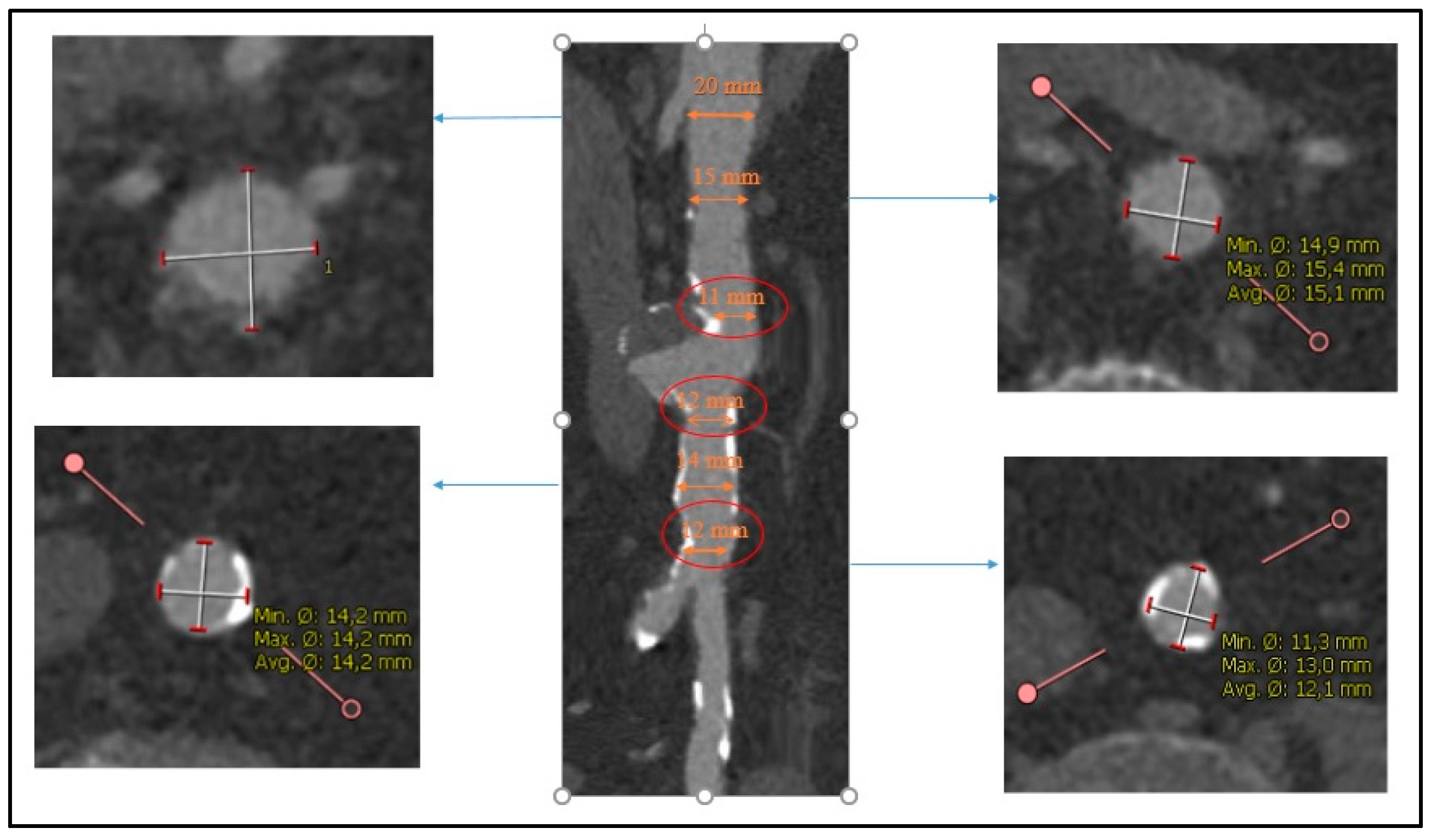


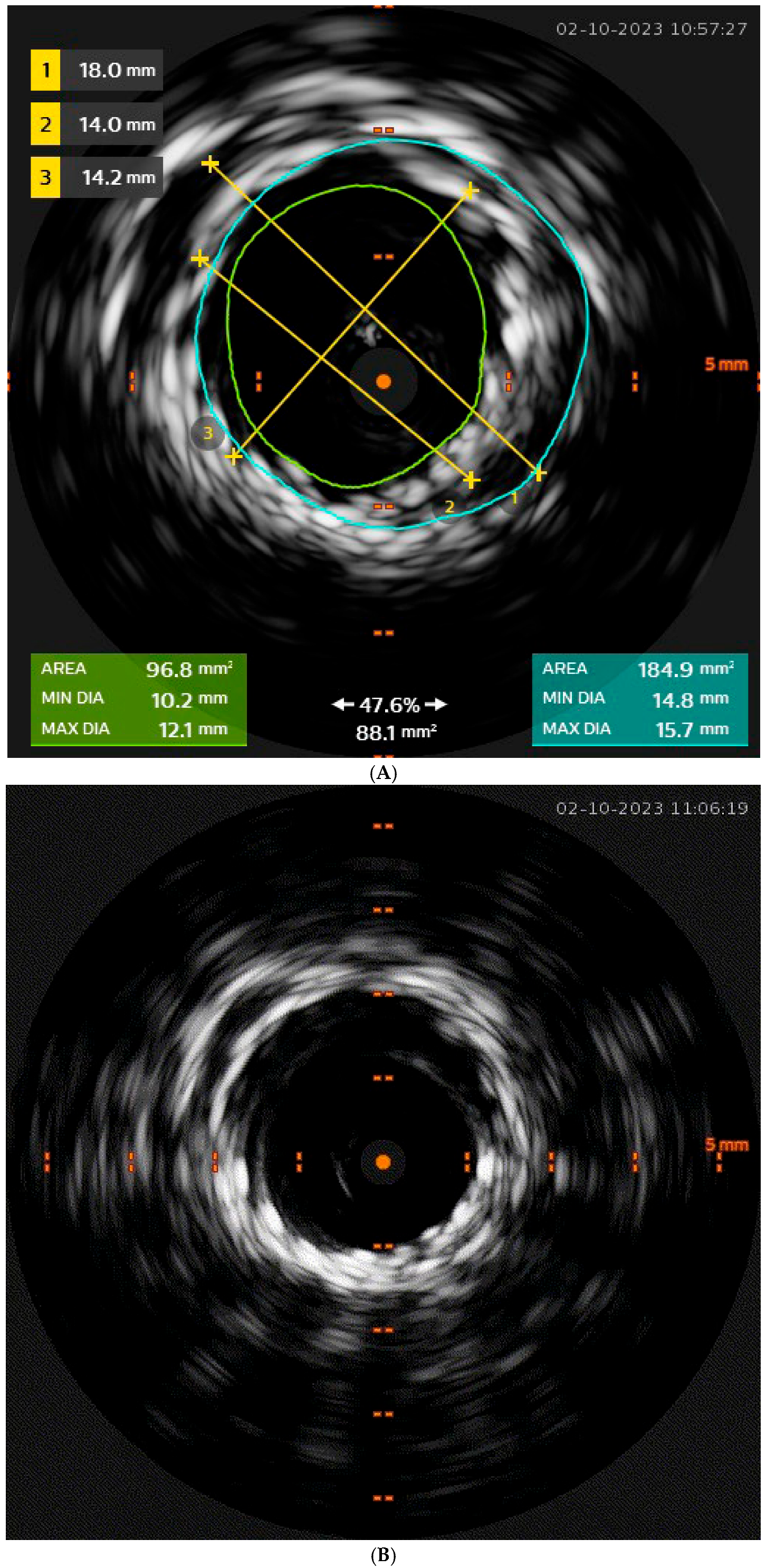
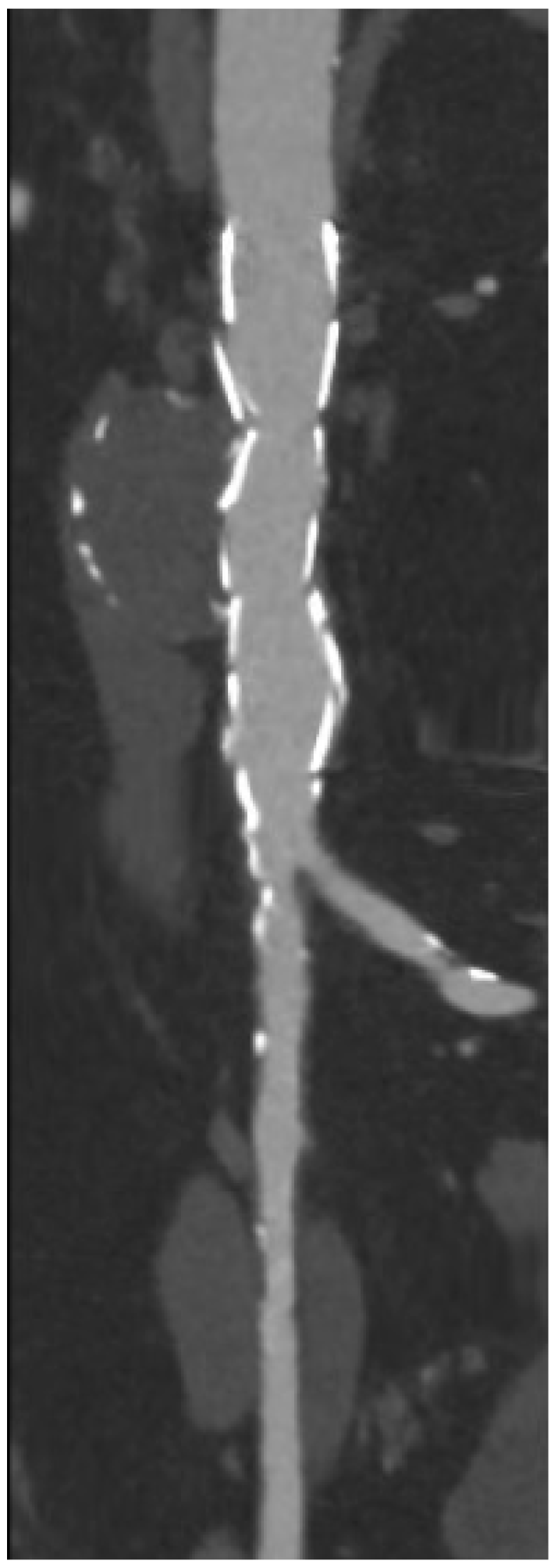


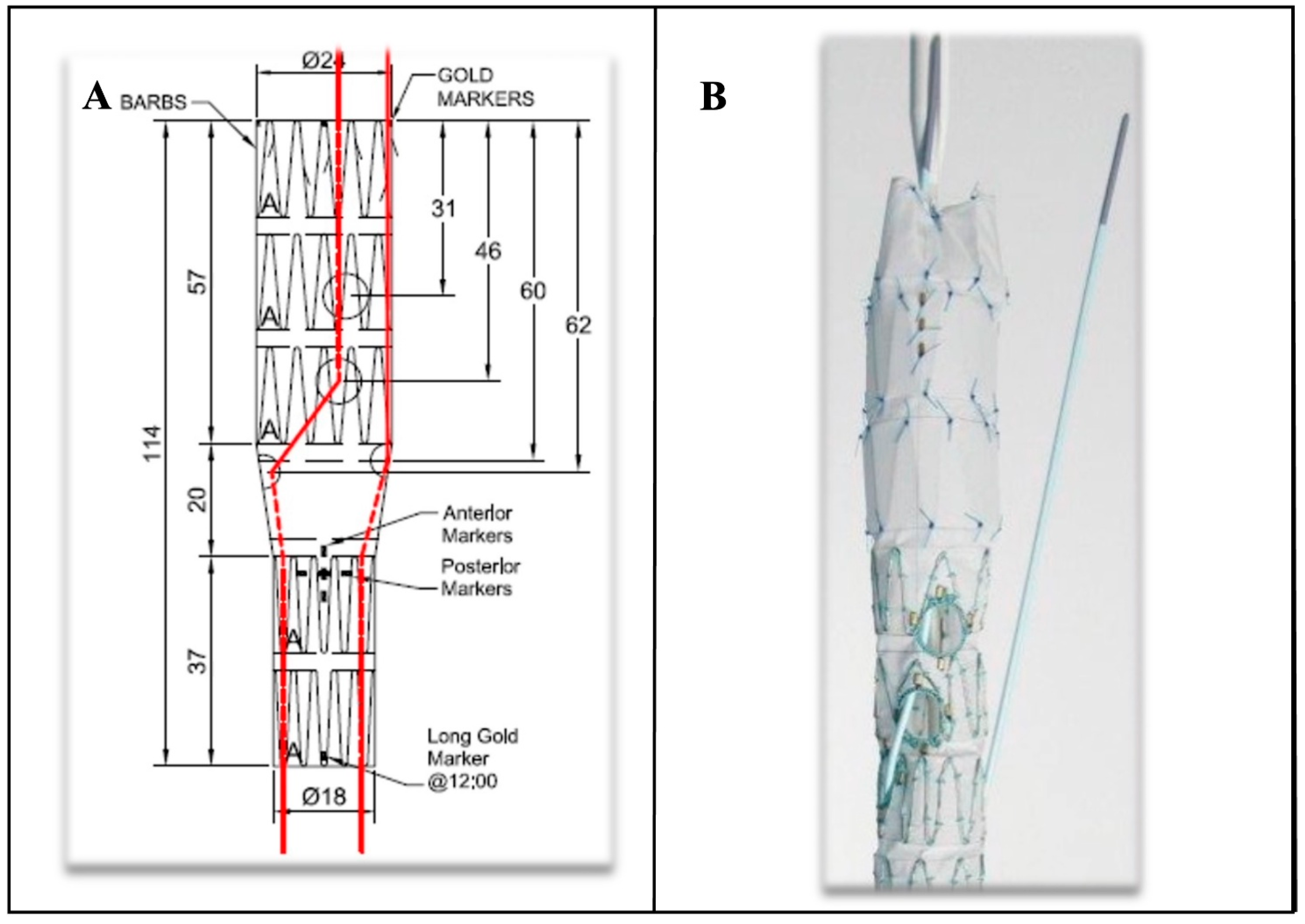
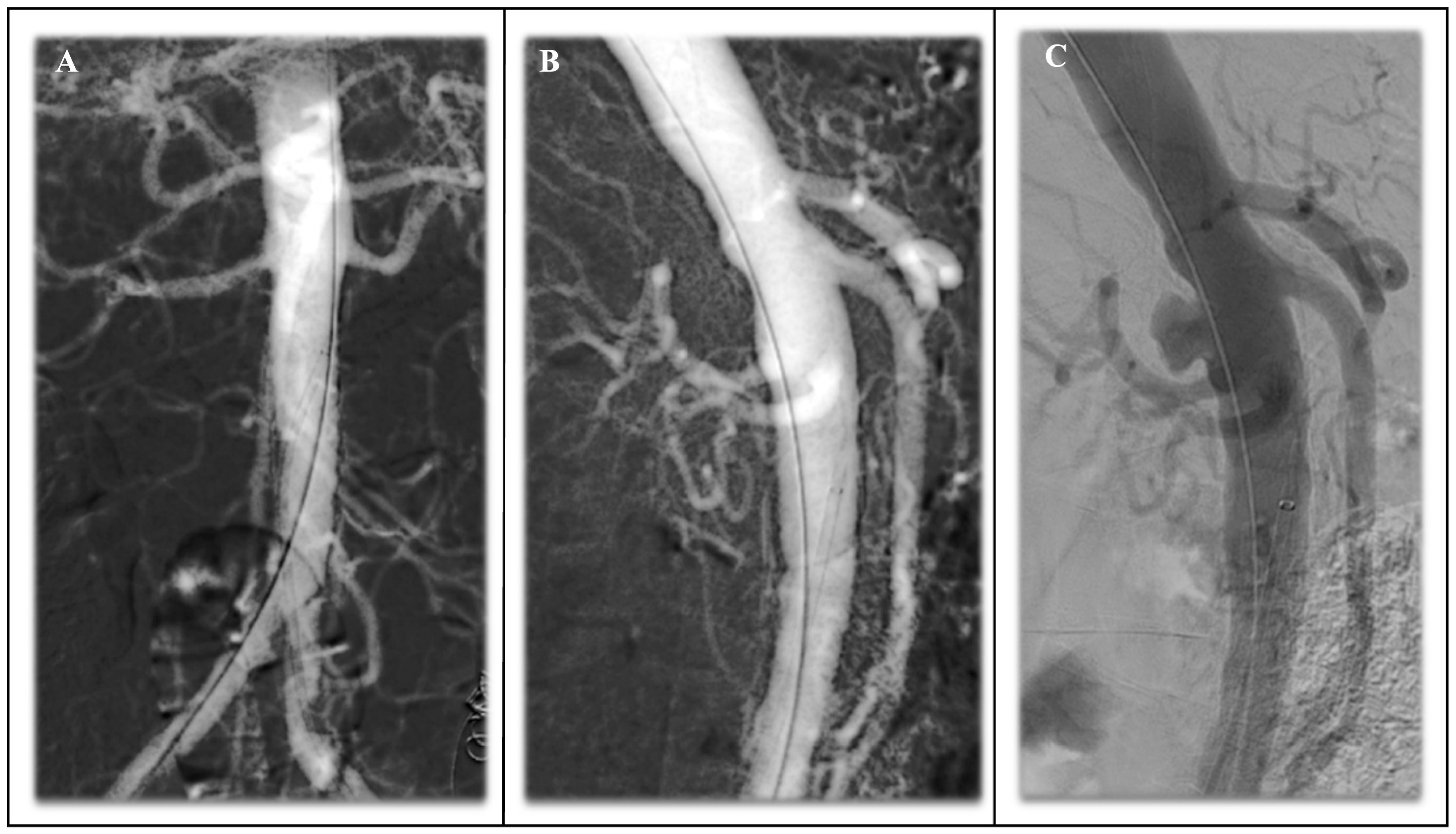
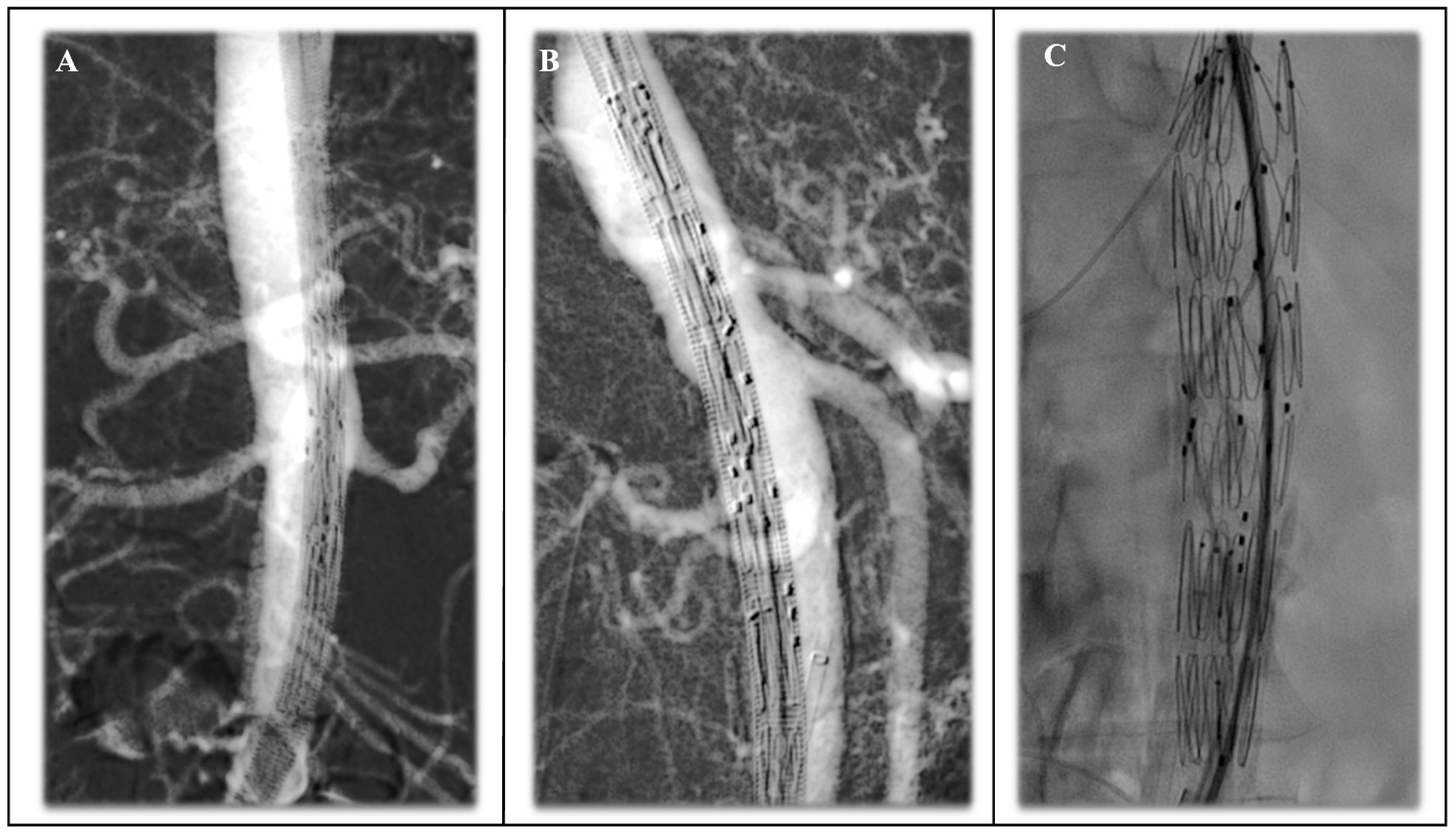
| Study (First Author) | Years | Number of Patients | Primary Pathology | Endovascular Technique | Device Used | Follow-Up (Months) | Mortality | Postoperative Complication |
|---|---|---|---|---|---|---|---|---|
| Stelter [41] | 1995 | 201 | AAA | “Double Tube” technique |
| 24 | 3.5% aortic-related:
| 9% Endoleak:
|
| York [37] | 2002 | 5 | s-AAA | “Stacked” Technique | AneuRx cuffs | 6.1 | No one | No one |
| Ruppert [47] | 2007 | 41 | s-AAA, PAU | “Trombone” technique | Zenith (custom), Powerlink | 21.9 | 9.8% (4/41) no aortic correlated | 9.8% Endoleak:
|
| Jones [48] | 2012 | 8 | s-AAA, PAU | “Trombone” technique | Zenith | 0.7 | No one | No one |
| Giagtzidis [38] | 2016 | 5/16 | s-AAA | “Telescopic” technique | Endurant cuffs | 12 | No one | Endoleak:
|
| D’Oria [49] | 2019 | s-AAA | Custom-made Unibody Conical Endograft | JOTEC Extra Design Engineering stent graft | 12 | No one | No one | |
| Hoshina [50] | 2022 | 48/175 | s-AAA | AFX Japan registry | AFX2 | 36 | 0.7% no aortic correlated | Endoleak:
|
Disclaimer/Publisher’s Note: The statements, opinions and data contained in all publications are solely those of the individual author(s) and contributor(s) and not of MDPI and/or the editor(s). MDPI and/or the editor(s) disclaim responsibility for any injury to people or property resulting from any ideas, methods, instructions or products referred to in the content. |
© 2025 by the authors. Licensee MDPI, Basel, Switzerland. This article is an open access article distributed under the terms and conditions of the Creative Commons Attribution (CC BY) license (https://creativecommons.org/licenses/by/4.0/).
Share and Cite
D’Oria, M.; Ascione, M.; Spath, P.; Piffaretti, G.; Gallitto, E.; Mansour, W.; Logiacco, A.M.; Badalamenti, G.; Cappiello, A.; Moretti, G.; et al. Narrative and Pictorial Review on State-of-the-Art Endovascular Treatment for Focal Non-Infected Lesions of the Abdominal Aorta: Anatomical Challenges, Technical Solutions, and Clinical Outcomes. J. Clin. Med. 2025, 14, 4798. https://doi.org/10.3390/jcm14134798
D’Oria M, Ascione M, Spath P, Piffaretti G, Gallitto E, Mansour W, Logiacco AM, Badalamenti G, Cappiello A, Moretti G, et al. Narrative and Pictorial Review on State-of-the-Art Endovascular Treatment for Focal Non-Infected Lesions of the Abdominal Aorta: Anatomical Challenges, Technical Solutions, and Clinical Outcomes. Journal of Clinical Medicine. 2025; 14(13):4798. https://doi.org/10.3390/jcm14134798
Chicago/Turabian StyleD’Oria, Mario, Marta Ascione, Paolo Spath, Gabriele Piffaretti, Enrico Gallitto, Wassim Mansour, Antonino Maria Logiacco, Giovanni Badalamenti, Antonio Cappiello, Giulia Moretti, and et al. 2025. "Narrative and Pictorial Review on State-of-the-Art Endovascular Treatment for Focal Non-Infected Lesions of the Abdominal Aorta: Anatomical Challenges, Technical Solutions, and Clinical Outcomes" Journal of Clinical Medicine 14, no. 13: 4798. https://doi.org/10.3390/jcm14134798
APA StyleD’Oria, M., Ascione, M., Spath, P., Piffaretti, G., Gallitto, E., Mansour, W., Logiacco, A. M., Badalamenti, G., Cappiello, A., Moretti, G., Di Marzo, L., Faggioli, G., Gargiulo, M., & Lepidi, S. (2025). Narrative and Pictorial Review on State-of-the-Art Endovascular Treatment for Focal Non-Infected Lesions of the Abdominal Aorta: Anatomical Challenges, Technical Solutions, and Clinical Outcomes. Journal of Clinical Medicine, 14(13), 4798. https://doi.org/10.3390/jcm14134798









